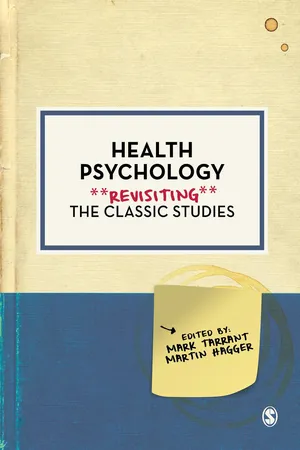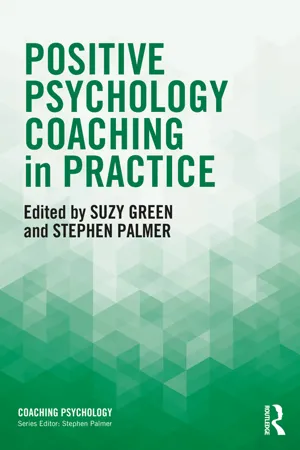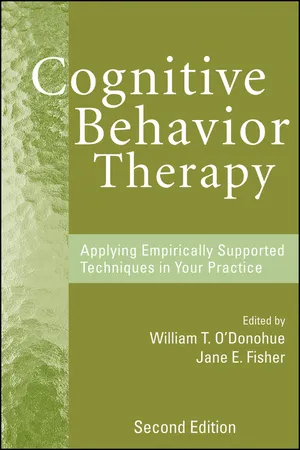Psychology
Martin Seligman
Martin Seligman is a prominent figure in the field of positive psychology, known for his work on learned helplessness and the concept of "positive psychology." He has contributed significantly to understanding human well-being and happiness, emphasizing the importance of focusing on strengths and virtues to improve mental health. Seligman's research has had a profound impact on the field of psychology.
Written by Perlego with AI-assistance
Related key terms
9 Key excerpts on "Martin Seligman"
- eBook - ePub
What Children Need to Be Happy, Confident and Successful
Step by Step Positive Psychology to Help Children Flourish
- Jeni Hooper(Author)
- 2012(Publication Date)
- Jessica Kingsley Publishers(Publisher)
While philosophy has considered what constitutes the ‘good life’ since ancient times, the scientific study of psychology was funded primarily to find ways to understand and alleviate complex needs such as mental illness and learning difficulties. Psychology in the twentieth century had become disconnected from most people’s lives and offered little practical guidance for everyday living. While psychology was respected for championing the needs of the disadvantaged, its focus on supporting people with disabilities and mental health needs had distanced mainstream psychology from most people’s lives.Positive Psychology is a comparatively new branch of science launched in 1998 by Professor Martin Seligman as his presidential theme during his year of office as President of the American Psychological Society. Professor Seligman invited the psychological community to refocus scientific study onto what promotes optimal wellbeing. Martin Seligman was in a unique position to help psychology broaden its impact to the lives of the many rather than the few. His research career had been pivotal in identifying the mechanisms underlying depression.Seligman and his colleagues identified the psychological process underlying depression which could be addressed directly. His team established that depression results from learned helplessness, a pessimistic mindset where people hold negative beliefs which deter them from attempting to improve their personal circumstances. As well as contributing to the development of Cognitive Behaviour Therapy, he had also had significant success with prevention programmes teaching the skills of optimism to challenge depressive thinking.6 For Seligman, as for many others in the psychology community, it made sense to move from reacting to human misery to developing prevention and from professionalized and complex care to giving people the skills to manage their own lives effectively.Seligman’s was not the first examination of psychological wellbeing. From the 1950s Humanistic Psychology sought to identify what gave life depth and meaning. The approach of the Humanistic Psychologists was theoretical; describing and explaining what creates wellbeing. It had a huge impact on the development of counselling and therapy but less influence on the general population. Humanistic Psychology was particularly interested in examining motivation. Abraham Maslow developed perhaps the best known theory of motivation7 - eBook - ePub
Cognitive Behavior Therapy
Core Principles for Practice
- William T. O'Donohue, Jane E. Fisher, William T. O'Donohue, Jane E. Fisher(Authors)
- 2012(Publication Date)
- Wiley(Publisher)
Chapter 13 Principles of Positive Psychology Jeana L. Magyar-MoePositive psychology is the scientific study of optimal human functioning, the goals of which are to better understand and apply those factors that help individuals and communities to thrive and flourish (Seligman & Csikszentmihalyi, 2000). When applied to counseling, psychotherapy, or behavior modification settings, the foundation of a positive psychological perspective is one of balance between working to repair identified problems while also attending to, promoting, and using areas of strength in the process (Magyar-Moe, 2009).Although positive psychology was not popularized until 1998 by Martin Seligman (Seligman, 2002), former president of the American Psychological Association, a focus on the positive within psychology represented two of three major foci of applied psychologists before World War II. More specifically, in addition to curing mental illness, psychologists focused on making the lives of all people more productive and fulfilling and identifying and nurturing talent (Seligman & Csikszentmihalyi, 2000). After World War II, however, the focus of applied psychologists narrowed to a point at which there was an almost exclusive focus on treating pathology. Following the war, the development of Veterans Administration hospitals proliferated, as did the availability of research funding by the National Institute of Mental Health for those researching cures for mental illness (Seligman & Csikszentmihalyi, 2000). Hence, psychologists realized that jobs and research funding were readily available to those who focused on mental illness. The same could not be said for those focusing on the other two original aims of applied psychology. - eBook - ePub
Health Psychology
Revisiting the Classic Studies
- Mark Tarrant, Martin S. Hagger, Mark Tarrant, Martin S. Hagger(Authors)
- 2023(Publication Date)
- SAGE Publications Ltd(Publisher)
14 Positive Psychology: Revisiting Seligman, Steen, Park, and Peterson (2005)Seligman, M. E. P., Steen, T. A., Park, N., & Peterson, C. (2005). Positive psychology progress: Empirical validation of interventions. American Psychologist, 60, 410–421.Ryan J. Goffredi, Christopher A. Sanders, Kennon M. Sheldon, and Laura A. KingBackground
Philosophers, scholars, theologians, and laypeople alike have pondered the question of how to live in a way that ultimately leads to happiness, thriving, and optimal functioning. What factors, actions, or material things (if any) promise to enhance happiness, not just temporarily but in the long run? This broad question has been approached in a multitude of ways over millennia, from the writings of Aristotle and religious scriptures to the more contemporary self-help movement. However, often lacking from these perspectives are prescriptions for happiness based on scientific evidence. Only relatively recently have some answers been provided by empirical research, particularly in the domain of positive psychology.What is positive psychology?
Positive psychology is a sub-field of psychology that is concerned with ‘understanding and building the qualities that make life worth living’ (Seligman, 1999, p. 3). More specifically, positive psychology is the study of positive emotions and experiences, the personality characteristics linked to these, and the institutions that foster them (Seligman & Csikszentmihalyi, 2000).As a discipline, positive psychology encompasses the work of researchers studying topics such as happiness, joy, gratitude, love, hope, optimism, forgiveness, flow, mastery, self-compassion, mindfulness, and meaning in life (Lopez & Snyder, 2009; Peterson, 2006). The focus of researchers working in this discipline extends beyond the individual to include relationships, families, communities, and societies (Peterson, 2006). Furthermore, positive psychology should be considered as capturing more than the study of happiness or well-being alone, but happiness is certainly a central focus.1 - Sharada Sugirtharajah, Sharada Sugirtharajah(Authors)
- 2022(Publication Date)
- Routledge(Publisher)
Long before Seligman announced his mission, the medical sociologist, Antonovsky (1979) created the concept of ‘salutogenesis’, an approach focusing on factors that support wellbeing, rather than those which cause disease (pathogenesis). Austrian-British social psychologist, Jahoda (1958), advocated for ‘positive mental health’. Seligman’s paradigm shift was not as radical as he had claimed. There was a growing feeling among many psychologists that the novelty of positive psychology had been exaggerated. Critiques emerged accusing the movement of ignoring its precursors, or even attempting to devalue, subjugate, and discredit humanistic psychology (Bohart & Greening, 2001; Taylor, 2001; McDonald & O’Callaghan, 2008). Seligman and Csikszentmihalyi (2000) had declared that the humanistic precursors of positive psychology had failed to establish a sufficiently robust empirical basis for their work, a view Wong (2018) deemed ‘dismissive and arrogant’ (p. 144).Seligman appeared chastened and modified his initial position, recognising precursors of positive psychology (Duckworth, Steen, & Seligman, 2005). Nonetheless, early skirmishes alienated some psychologists. While academic criticism of positive psychology has not been limited to this lack of historical positioning, Wong (2018) has elitism, scientism, dichotomous thinking, and replication issues among others in his sights, and one cannot help feeling this initial false step did lasting damage to the reputation and academic standing of the field.Individual and collective wellbeing
Seligman and Csikszentmihalyi predicted, ‘a psychology of positive human functioning will arise that achieves a scientific understanding and effective interventions to build thriving in individuals, families and communities’ (Seligman & Csikszentmihalyi, 2000, p. 13). Though they spoke of positive psychology in collectivist terms as the ‘scientific study of optimal human functioning [that] aims to discover and promote the factors that allow individuals and communities to thrive’ (Seligman & Csikszentmihalyi, 2000, p. 5), in practical terms its emphasis has been largely limited to promoting the wellbeing of individuals. This goes with the focus on cultivating positive emotions and ‘signature strengths’ which inevitably foreground the individual. Culturally speaking, positive psychology can be located within the tradition of Western individualism drawing heavily on philosophies dating back to the Enlightenment (Maracek & Christopher, 2018). Some commentators identify positive psychology as a specifically ‘American’ brand of individualism that sanctions the pursuit of happiness as an inalienable human right (Ehrenreich, 2010).- eBook - ePub
- Emmy van Deurzen(Author)
- 2008(Publication Date)
- SAGE Publications Ltd(Publisher)
The main authors of this movement are people like Seligman and his concept of authentic happiness (Seligman, 2002), Diener and his notion of subjective well being (Diener, 2000; Diener and Suh, 2000) and before that Veenhoven (1984), who has the merit of having surveyed various countries and classes of society to draw conclusions about the state of happiness in various parts of the world. All these authors have wonderful intentions of improving the human condition and are well worth reading. Their books are certainly more inspiring than many other psychology books and go some way to counterbalance psychologists’ preoccupation with pathology. But at the end of their rhetoric we are left with the same old human quandaries and there is a possibility that their strong desire to make things better can only make things worse by making us expect more than is reasonable. Any system that doesn’t face the negatives of life and fails to integrate them is doomed to making a big mistake.And yet this new branch of psychology has some important contributions to make in providing us with information and research on aspects of human living that other approaches have missed out. Take for instance Seligman’s investigation of signature strengths, which can help us to inventorize a person’s virtues and character strengths, putting the emphasis on potential instead of on character flaws and pathology, as standard personality inventories tend to do. If we want to systematize psychology, we might as well do it in a positive way and help individuals articulate what they are best at in order to maximize these strengths. The values that Seligman describes (2002) sound familiar. He speaks of:- Wisdom
- Courage
- Love
- Justice
- Temperance
- Transcendence
These concepts can be found in many philosophical and pastoral systems and introducing them into psychology seems like a good thing. But there is also a real danger of reducing philosophical thinking to its bare bones and cheapening the ideas in the process. Concepts that are complex and deserve debate and in depth reflection get minimized and used in an instrumentalist fashion. They become narrowly defined and turned into a manualized commodity for mass consumption. Is this the way to teach people how to live their lives better? Or is this another example of using the latest technology to simplify our lives only to find that we have missed out the essentials? Building high rise apartment blocks that use the latest technology but still provide second rate living conditions is not progress. Helping people to get access to a place they can truly call home and that is worth investing in and looking after and where they can cultivate their own garden is far more worthwhile. In this case this would mean teaching people to think about living rather than telling them how to do it. - eBook - ePub
Education and Schmid's Art of Living
Philosophical, Psychological and Educational Perspectives on Living a Good Life
- Christoph Teschers(Author)
- 2017(Publication Date)
- Routledge(Publisher)
Chapter 5 , can broaden this understanding and provide a more holistic view on the topic.4.1 The relevance of positive psychology for an art of living
Psychology is traditionally a science concerned with the question of what is wrong with people. The art of living, on the other hand, is more concerned about how to get it right. Therefore, it seems necessary to give a short introduction about how these two areas are connected and why this connection is important for an educational approach.Beginning in the middle of the 20th century an increasing number of psychologists shifted their focus of research from the pathological question of “What is wrong with humans?” to the more positive research question of “What is right?”. This new focus became known later as the field of positive psychology, which was introduced under this name around the year 2000 by Martin Seligman and Mihaly Csikszentmihalyi, who have since been known as the founders of this new area of psychological research. The term positive psychology subsumes a range of areas, including flow, positive emotions, wisdom and knowledge, happiness and well-being, creativity, strengths and values, (life) goals, positive coping strategies, humour and many more (Boniwell 2008, 1–6). As this area of research has grown significantly in the last 15 years, the focus in this chapter lies on Martin Seligman’s (2010) book Authentic Happiness, which provides a good overview of positive psychology, and the book Flow from Michael Csikszentmihalyi (2008), which offers insights in one of the main theories for happiness and well-being. Csikszentmihalyi also includes some thoughts about the history and development of happiness in humanity.The contribution positive psychology can make to an educational approach to the art of living is manifold and singular at the same time. The main focus of positive psychology lies in explaining and increasing happiness and positive emotions, which appears to be a singular topic. On the other hand, research shows that such an increase has a positive effect on health, performance, creativity and coping with negative emotions, and it also prolongs life1 - eBook - ePub
- Meg A. Warren, Stewart I. Donaldson, Meg A. Warren, Stewart I. Donaldson, Meg A. Warren, Stewart I. Donaldson(Authors)
- 2017(Publication Date)
- Praeger(Publisher)
positive psychology movement inspired interest in the well-being of organizations and employees. In their seminal conceptualization of positive psychology, Seligman and Csikszentmihalyi (2000) considered positive institutions as a pillar and the context in which positive states (e.g., flow, hope, and positive emotions) were experienced and positive characteristics (e.g., creativity, meaning, and purpose) were cultivated and practiced. Consequently, they construed positive institutions broadly as including organizations, education, marriage, family, religion, judicial systems, governments, and societies. While in this broad, generalized form it remained a rather underdeveloped area of positive psychology (Hart & Sasso, 2011), the conceptual and philosophical orientation of positive psychology caught the interest of applied organizational researchers and practicing managers. As such, positive psychology constructs (e.g., well-being, flow, meaning, and mindfulness) that were gaining momentum in social, personality, cognitive, and other areas of psychology were introduced and studied in the applied settings of organizations. Some of the growing areas of research in organizational psychology became employee well-being (Page & Vella-Brodrick, 2009; Wright, 2010), meaning (Steger & Dik, 2010), positive leadership (Diener, 2000), coaching (Grant & Spence, 2010), mindfulness at work (Good, et al. 2016), and organizational interventions that enhance positive work experiences, build positive employee traits, and foster positive institutions (Meyers, van Woerkom, & Bakker, 2013).Inspired by the presentations of Seligman, Diener, Csikszentmihalyi, and Fredrickson at the inaugural Positive Psychology Summit at the Gallup Organization in Lincoln, Nebraska, in 1999, University of Nebraska organizational behavior professor, and at the time a fellow Gallup senior scientist with the presenters, Fred Luthans had a trigger moment to take this newly emerging positive psychology to the workplace (see Luthans, in press and Luthans & Avolio, 2009 for more details). Soon after, Luthans published the first work on what he termed positive organizational behavior - eBook - ePub
- Suzy Green, Stephen Palmer, Suzy Green, Stephen Palmer(Authors)
- 2018(Publication Date)
- Routledge(Publisher)
The first path involved the Pleasant Life that has the objective of maximising positive emotion or pleasure and minimising negative emotions. Seligman observed that this hedonistic life orientation may be pleasing, even addictive, but could ultimately be empty unless supplemented by additional life orientations that pursued engagement and meaning. The Engaged Life involves engaging in carefully measured challenges that capitalised on one’s natural strengths and that are closely matched to one’s skills to produce a state of flow. Flow is an attentional and emotional state characterised by complete absorption in an intrinsically rewarding activity where skills are closely matched to challenges and opportunities (Csikszentmihályi, 1990). Finally, Seligman asserted that a good life also involved the pursuit of some valued outcomes that were larger than mere self-interest. The Meaningful Life (often referred to by the Greek term “Eudaimonia”) involves working towards a purpose or an outcome that benefited others or something beyond our self. This could be accomplished in many ways, such as promoting others welfare, and could be influenced by one’s religion or philosophy of life. Authentic Happiness Theory thus proposes that a truly satisfying good life required the pursuit of each of these pathways in varying degrees. Seligman’s PERMA theory (Seligman, 2011) expanded on his earlier theory by adding two additional elements: Positive Relationships and Accomplishment. PERMA thus stands for: P – Positive emotion (the Pleasant Life) E – Engagement (the Engaged Life) R – Positive Relationships M – Meaning (the Meaningful Life) A – Accomplishment. The PERMA Theory is not truly a needs-based theory, rather it identifies five pathways to well-being, although positive relations, accomplishment, and meaning/purpose may be seen as needs. It does, however, provide the coach with a variety of well-documented and evaluated strategies that may be used to promote well-being - eBook - ePub
Cognitive Behavior Therapy
Applying Empirically Supported Techniques in Your Practice
- William T. O'Donohue, Jane E. Fisher, William T. O'Donohue, Jane E. Fisher(Authors)
- 2008(Publication Date)
- Wiley(Publisher)
Current Concepts of Mental Health was published in 1958 and outlined what she believed to be the six components of positive mental health (Cowen & Kilmer, 2002; Duckworth et al., 2005; Seligman et al., 2005). This provided the foundation for subsequent work in the area, which focused primarily on practices to prevent psychological dysfunction, although more contemporary work has also focused on enhancing well-being in addition to preventing dysfunction (Cowen & Kilmer, 2002).CURRENT PERSPECTIVES IN THE POSITIVE PSYCHOLOGY MOVEMENT
In response to the somewhat heated debate about the influences and origins of positive psychology, Martin Seligman responded with his perspective about what he believes to be the origin of positive psychology. He noted that positive psychologists do not believe that they “invented” the subfield of positive psychology, independent of the aforementioned historical antecedents (Seligman et al., 2005). Instead, he argues that positive psychologists have united many separate lines of research and theory occurring across disciplines, have worked to create an overarching conceptual structure, and have more heavily emphasized the importance of rigorous, scientific study of areas pertaining to positive psychological thought (Duckworth et al., 2005; Seligman et al., 2005). Using this understanding of the origin of positive psychology, it could be argued that Seligman’s election as president of the American Psychological Association in 1998 represents the origin of positive psychology. Since 1998, the First Positive Psychology Summit in 1999 and the issue of the American Psychologist devoted entirely to positive psychology in 2000 are considered to be two critical events in the recognition of contemporary positive psychology (Bacon, 2005; Simonton & Baumeister, 2005). In the decade since positive psychology was first identified as a subfield of psychology, numerous books have been published, meetings have been held, centers have been developed, and graduate courses have been created (Seligman et al., 2005).
Index pages curate the most relevant extracts from our library of academic textbooks. They’ve been created using an in-house natural language model (NLM), each adding context and meaning to key research topics.








